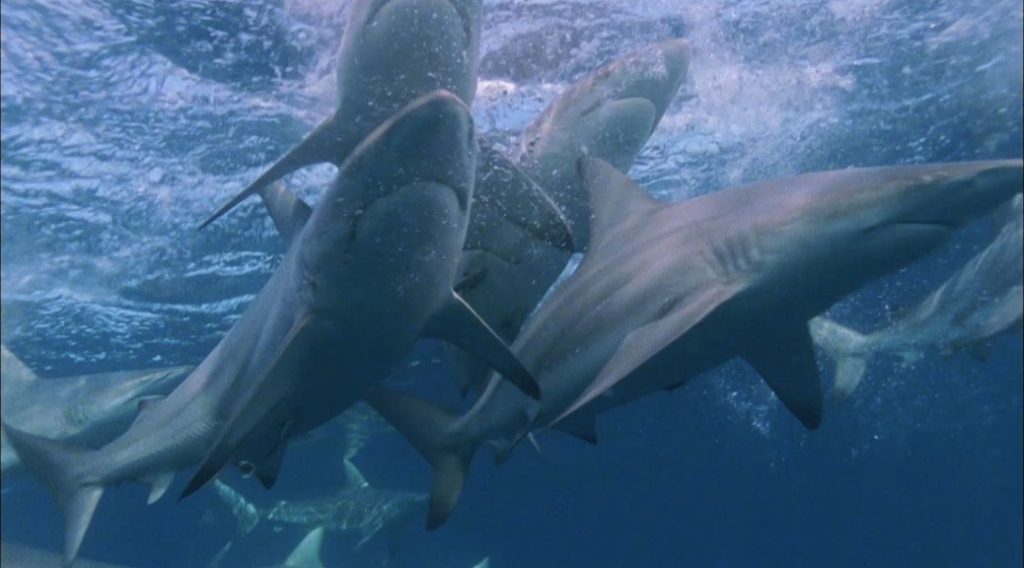SHARK WEEK 2015 Extra: Shark Fest – Shark Alley and United Sharks of America
on Nat Geo Wild
Pros: Shark Alley is an outstanding nature doc, and United Sharks is a commendably levelheaded and fact-based examination of American shark attacks
Cons: Not as slam bang a block of programming as what Discovery Channel typically provides
Cashing in on the wild popularity of “that other thing” (read: Discovery Channel’s Shark Week), Nat Geo Wild channel let loose with their own block of shark-related programming (labeled “Shark Fest”) on Sunday, July 5, 2015. This opening night saw the premieres of a pair of documentaries, the more or less straight-forward nature documentary Shark Alley and a program in United Sharks of America that examined the most “dangerous” shark states in the US. This type of program typically rubs me the wrong way since they almost effortlessly confirm sharks as the “eating machines” they were made out to be in Jaws and any number of other Hollywood films, but United Sharks actually is somewhat more responsible in its approach than the usual “I was bitten” program. All in all, these two programs are a worthy supplement to the generally outstanding Discovery Channel lineup.
Prepare for some eye-popping images in Shark Alley.
Shark Alley stands as a typically excellent National Geographic wildlife documentary, one that focuses its attention on a somewhat unusual topic. Essentially, this program deals with the “sardine run” that occurs each winter off the South African coast, in which the small fish travel some 700-plus miles from the Capetown area to KwaZulu-Natal. Unsurprisingly, the concentration of prey created when billions upon billions of sardines pack together and begin their migration peaks the interest of a seemingly endless array of predators. According to the program, the sardine run leads to the biggest predation event in the world, and the documentary does a fine job of giving the viewer some indication of how large it really is through the use of almost unbelievable aerial shots that show a huge mass of sardines drifting much like an oil slick would just off the South African beaches.
Shark versus seal.
Instead of exclusively focusing on the sardines themselves however, the main point of interest in Shark Alley are the various species that prey on them. To that end, the documentary includes some astounding underwater images of sea birds dive-bombing the wriggling whirlwind of fish as well as seals, dolphins, various species of shark, and even full-size whales snacking on the sardines. As is typically the case in National Geographic programs, while the main narrative about the migration continues, a viewer is treated to brief asides that serve to explain various other facets of the creatures being seen in the documentary. Thus, footage of a great white shark stalking a mother seal searching for her pup as well as explanations about shark physiology are able to be incorporated into the proceedings. Well-rounded and top-notch in most every area, I think Shark Alley works best as a graphic illustration of the complexities of the food chain: it’s pretty amazing to learn that the sardine migration is not only essential for the survival of these small fish, but also key in the life cycle of dozens of other marine creatures and even birds.
United Sharks of America is a bit of a different animal, playing as a countdown through the top five most dangerous regions in the US with regard to shark attacks. Various attack survivors tell their stories, while a panel of shark experts attempts to explain why these incidents took place. The occasional reenactment pops up to get the viewer more into the stories, and the program does include some rather graphic images of the resulting wounds. As I mentioned, this is usually the type of shark-related program that I find distasteful: sharks have been portrayed in the media as evil, man-eating creatures for decades, resulting in a public that for a long period of time had no problem exterminating them completely. United Sharks is slightly better than the average program in its portrayal of sharks however: all the attacks chronicled here were non-fatal, and most of the interview subjects explain that they have no ill-feelings toward their attackers. The documentary actually ends with a segment focusing on a group of survivors who have taken up shark conservation efforts in the aftermath of their attacks.
Overall, the opening night of Shark Fest was worthwhile though not remarkable. The Shark Alley documentary was extremely well-made with some magnificent photography (a shot filmed through a sea-side cliff showing the commotion going on out at sea is jaw-dropping), and United Sharks of America is more progressive in its underlying message than I would have thought. Even if this second program didn’t really provide much new information to me specifically, there’s no doubt it would be helpful and interesting to viewers who might not have as clear an understanding of sharks and their behavioral patterns. These two shows appear to be the only brand new documentaries aired on Nat Geo Wild throughout the week, and though I probably wouldn’t label either as must-see television, they’re far from being a complete waste of time – if you’re interested and they’re on, check them out.
Four stars for Shark Alley, three for United Sharks of America.

